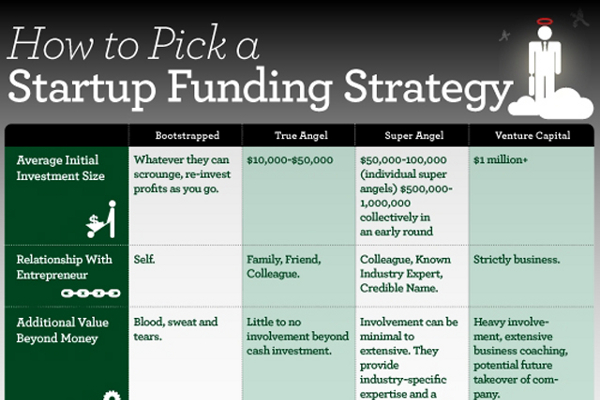Ways To Get Capital To Start A Business

In the perilous yet exhilarating journey of entrepreneurship, the quest for initial capital often stands as the first, and perhaps most daunting, hurdle. Dreams of innovative startups and flourishing small businesses frequently stall not for lack of vision or talent, but due to the scarcity of readily available funding. This scarcity has forced aspiring business owners to become creative and resourceful in securing the financial lifeline their ventures desperately need.
This article explores the diverse avenues available to entrepreneurs seeking capital to launch their businesses, ranging from traditional loans and venture capital to crowdfunding and bootstrapping. We'll delve into the intricacies of each option, examining their benefits, drawbacks, and suitability for different types of ventures. The goal is to provide a comprehensive overview, empowering aspiring business owners to make informed decisions about the funding strategies that best align with their specific needs and circumstances.
Traditional Lending: A Familiar Path
Traditional bank loans remain a cornerstone of small business financing. These loans, often secured by collateral, offer relatively low interest rates for qualified borrowers.
However, securing a bank loan can be challenging for startups with limited operating history or assets. Banks typically require a solid business plan, strong credit history, and demonstrable ability to repay the loan.
The Small Business Administration (SBA) offers loan guarantee programs designed to reduce the risk for lenders, making it easier for small businesses to access financing. These programs, such as the 7(a) loan program, can provide crucial support for startups seeking traditional funding.
Venture Capital: High Risk, High Reward
Venture capital (VC) is a form of private equity financing provided by firms or funds to startups and small businesses with high growth potential. VCs invest in exchange for equity, meaning they own a portion of the company.
VC funding is typically available to companies in industries like technology, biotechnology, and healthcare, where there's potential for rapid scaling. However, securing VC funding is highly competitive, and it often comes with significant oversight and control from the investors.
According to the National Venture Capital Association (NVCA), venture capital investments reached record levels in recent years, but the funding landscape can shift quickly based on market conditions. Entrepreneurs should carefully consider the implications of giving up equity and the potential loss of control before pursuing VC funding.
Angel Investors: A Bridge to Growth
Angel investors are wealthy individuals who invest their own money in early-stage companies. Unlike VCs, angel investors typically provide smaller amounts of funding and may offer mentorship and guidance in addition to capital.
Angel investors often invest in companies within their area of expertise, providing valuable industry knowledge and connections. Networking and building relationships with angel investors are crucial steps for entrepreneurs seeking this type of funding.
Organizations like Angel Capital Association (ACA) provide resources and support for both angel investors and entrepreneurs seeking funding. Their platform connects startups with potential investors.
Crowdfunding: Tapping into the Crowd
Crowdfunding has emerged as a popular alternative to traditional funding sources. Platforms like Kickstarter and Indiegogo allow entrepreneurs to raise money from a large number of individuals in exchange for rewards, equity, or donations.
Crowdfunding can be an effective way to validate a product or service and generate early buzz for a new business. However, successful crowdfunding campaigns require significant marketing and outreach efforts.
There are different types of crowdfunding, including reward-based crowdfunding, equity crowdfunding, and debt crowdfunding. Entrepreneurs should carefully consider which type of crowdfunding best suits their needs and regulatory requirements.
Bootstrapping: The Power of Self-Reliance
Bootstrapping involves funding a business through personal savings, revenue generated by the business, and minimal external funding. This approach requires careful financial management and a strong focus on profitability.
Bootstrapping allows entrepreneurs to maintain full control of their company and avoid the dilution of equity. However, it can be challenging to grow rapidly without external funding.
Many successful companies, including Dell and Microsoft, started as bootstrapped ventures. This demonstrates the potential of self-reliance and disciplined financial management.
Government Grants and Programs
Federal, state, and local governments offer various grants and programs to support small businesses. These programs may provide funding for specific purposes, such as research and development or job creation.
The Small Business Innovation Research (SBIR) and Small Business Technology Transfer (STTR) programs provide funding for small businesses engaged in innovative research and development. These grants can be highly competitive but offer significant financial support.
Entrepreneurs should research and explore the available grant programs in their region and industry. They must also carefully review the eligibility requirements and application process.
Looking Ahead
Securing capital remains a critical challenge for entrepreneurs, but the options available are more diverse than ever before. From traditional loans and venture capital to crowdfunding and bootstrapping, entrepreneurs can choose the funding strategies that best align with their needs and goals.
As the startup ecosystem continues to evolve, new funding models and platforms are likely to emerge, further expanding the opportunities for entrepreneurs to access capital. The key to success lies in careful planning, thorough research, and a relentless pursuit of the funding that will fuel their dreams.
Ultimately, the ability to secure funding is a testament to an entrepreneur's vision, perseverance, and commitment to building a successful business. The journey may be challenging, but the rewards can be immense.


















